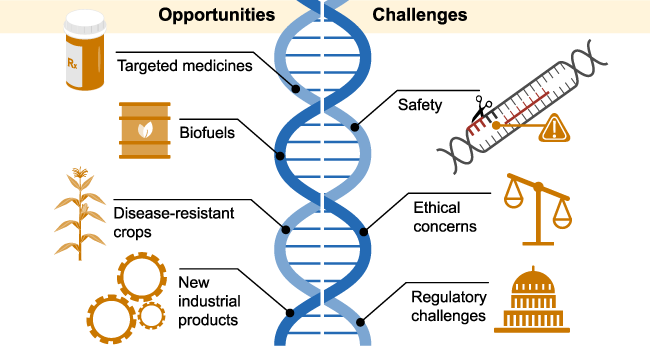New Gene Editing Technique
Why in News
The proposal for Indian regulators to consider a new gene editing technique has been pending with the Genetic Engineering Appraisal Committee for almost two years.
Gene Editing
- Genome editing (also called gene editing) is a group of technologies that give scientists the ability to change an organism's Deoxy-Ribonucleic Acid (DNA).
- These technologies allow genetic material to be added, removed, or altered at particular locations in the genome.
Key Points
- About:
- The Indian Agricultural Research Institute (IARI) has now moved to newer technologies such as Site Directed Nuclease (SDN) 1 and 2.
- New technique aims to bring precision and efficiency into the breeding process using gene editing tools such as CRISPR (Clustered Regularly Interspaced Short Palindromic Repeats), whose developers won the Nobel Prize for Chemistry in 2020.
- SDN genome editing involves the use of different DNA-cutting enzymes (nucleases) that are directed to cut the DNA at a predetermined location by a range of different DNA binding systems.
- After the cut is made, the cell’s own DNA repair mechanism recognizes the break and repairs the damage, using one of two pathways that are naturally present in cells.
- It involves the use of gene editing tools to directly tweak (improve\change) the plant’s own genes instead.
- It would allow plants to be genetically modified without the need for conventional transgenic technology.
- Current Application:
- A research coalition under the Indian Council of Agricultural Research (ICAR), which includes the IARI, is using these techniques to develop rice varieties which are drought-tolerant, salinity-tolerant and high-yielding. They could potentially be ready for commercial cultivation within three years.
- The IARI has previously worked on golden rice, a traditional GM variety which inserted genes from other organisms into the rice plant, but ended trials over five years ago due to agronomic issues.
- A research coalition under the Indian Council of Agricultural Research (ICAR), which includes the IARI, is using these techniques to develop rice varieties which are drought-tolerant, salinity-tolerant and high-yielding. They could potentially be ready for commercial cultivation within three years.
- Significance of New Techniques:
- Safe:
- In this case, you are just tweaking a gene that is already there in the plant, without bringing in any gene from outside.
- When a protein comes from an outside organism, then you need to test for safety. But in this case, this protein is right there in the plant, and is being changed a little bit, just as nature does through mutation.
- Fast:
- It is much faster and far more precise than natural mutation or conventional breeding methods which involve trial and error and multiple breeding cycles. It is potentially a new Green Revolution.
- Safe:
- Status of New Techniques Globally:
- The U.S, Canada, Australia and Japan are among the countries which have already approved the SDN 1 and 2 technologies as not akin to GM, so such varieties of rice can be exported without any problem.
- The European Food Safety Authority has also submitted its opinion that these technologies do not need the same level of safety assessment as conventional gene mutation, though the European Union is yet to accept the recommendation.
- Related Laws in India:
- In India, several rules, guidelines, and policies backed by the “Rules for the Manufacture, Use, Import, Export and Storage of Hazardous Microorganisms/Genetically Engineered Organisms or Cells, 1989” notified under the Environment Protection Act, 1986, regulate genetically modified organisms.
- Apart from it, the National Ethical Guidelines for Biomedical and Health Research involving human participants, 2017, by the Indian Council of Medical Research (ICMR), and the Biomedical and Health Research Regulation Bill implies regulation of the gene-editing process.
- This is especially so in the usage of its language “modification, deletion or removal of parts of heritable material”.
- However, there is no explicit mention of the term gene editing.
Genetic Engineering Appraisal Committee
- It functions under the Ministry of Environment, Forest and Climate Change (MoEF&CC).
- It is responsible for the appraisal of activities involving large-scale use of hazardous microorganisms and recombinants in research and industrial production from the environmental angle.
- The committee is also responsible for the appraisal of proposals relating to the release of genetically engineered organisms and products into the environment including experimental field trials.
- GEAC is chaired by the Special Secretary/Additional Secretary of MoEF&CC and co-chaired by a representative from the Department of Biotechnology (DBT).
